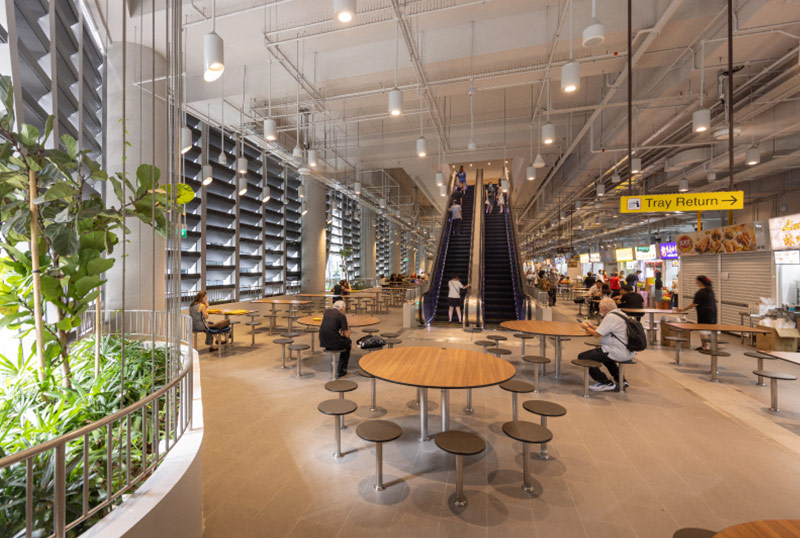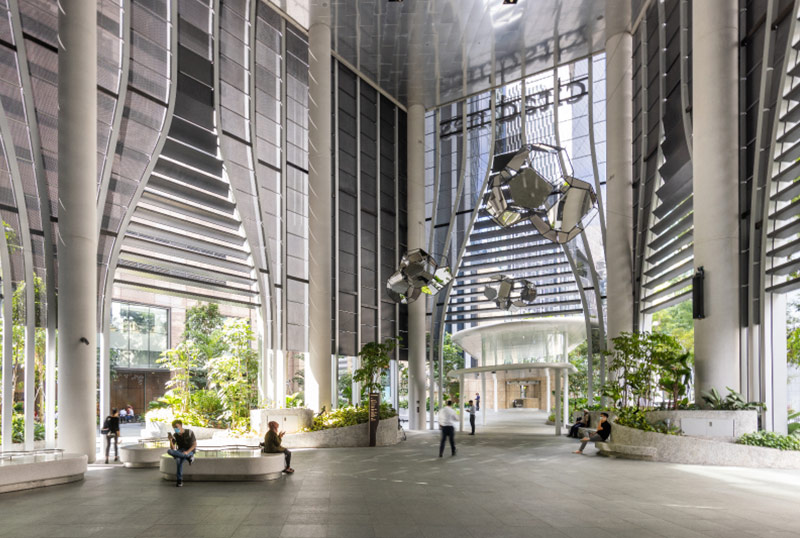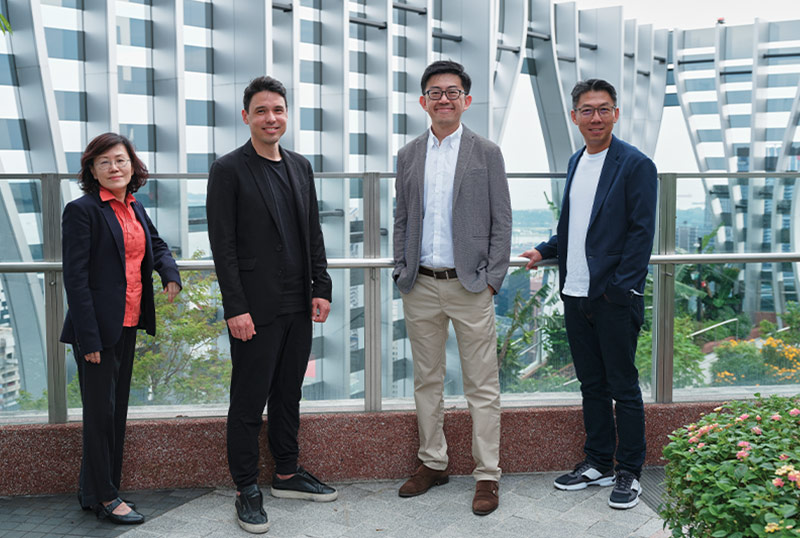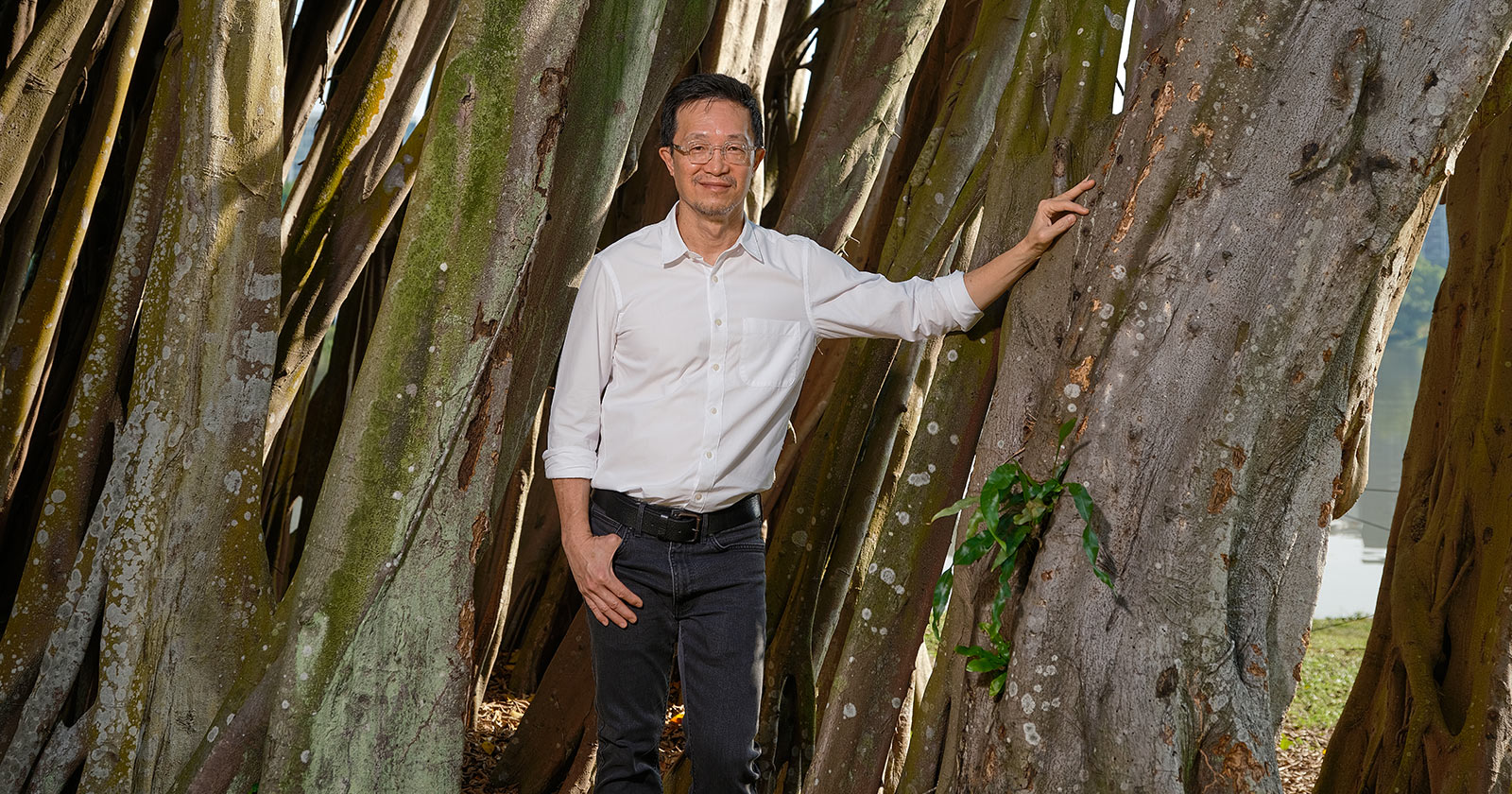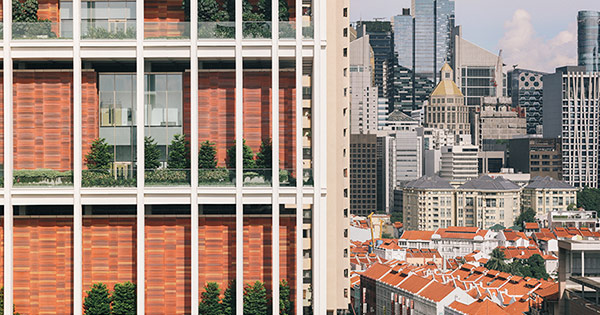DESIGN OF THE YEAR 2023
CapitaSpring
Designer
Bjarke Ingels Group
In collaboration with RSP Architects Planners &
Engineers (Pte) Ltd and Carlo Ratti Associati
CONTACT
[email protected]
[email protected]
Rising some 280 metres from the ground, CapitaSpring is a striking new addition to the Singapore skyline. It stands out not only as one of the tallest buildings in the city-state, but also as one of the greenest amongst its glass, steel, and concrete neighbours in the Central Business District (CBD).
A voluminous “City Room” integrated with a public park offers a welcoming entrance into the tower grounds where one can grab a drink, participate in community events, or head to the Market Street Hawker Centre that has been rehoused from the original development. The tower’s distinctive pinstripe facade peels open between the 17th and 20th floors to reveal a verdant sky terrace in the mixed-use development. Within this “Green Oasis”, workers in the offices above and residents in the serviced apartments below can dine at the bistro, exercise at an outdoor gym, meet at work pods, or simply enjoy the outdoor breeze. Right at the top of the 51-storey tower is a rooftop restaurant and an urban farm that offers breathtaking city views.
While taking tropical urbanism to new heights in Singapore, the tower designed by the Bjarke Ingels Group (in collaboration with Carlo Ratti Associati) and RSP Architects Planners and Engineers generously extends into its surroundings too. Its multi-level green spaces are open to the tower’s users as well as the general public, offering a new social realm for the community to come together not just for work but to live and play too.
About the Designer
Bjarke Ingels Group (BIG) was founded in 2005 by Danish architect Bjarke Ingels and is responsible for some of the most forward-thinking examples of modern architecture in the world. Brian Yang joined BIG in 2007 and was named Partner in 2015. With a background in energy efficiency research as well as economics, Yang brings an additional focus on environmental and economic sustainability into his projects. He has been the Project Leader on several competition-winning proposals, including the CopenHill waste-to-energy plant in Copenhagen that doubles as a ski slope and the LEGO House. Most recently, he has been the partner-in-charge for the competition-winning scheme for the Vltava Philharmonic Hall in Prague.
DESIGN FIRM
Bjarke Ingels Group
In collaboration with Carlo Ratti Associati
PROJECT MANAGER
CapitaLand Development Pte Ltd
LIGHTING DESIGNER
Nipek Pte Ltd
INTERIOR DESIGNER (SERVICED RESIDENCE)
Takenouchi Webb Pte Ltd
QUANTITY SURVEYOR
Asia Infrastructure Solutions Singapore Pte Ltd
CLIENT
CapitaLand Development Pte Ltd
CapitaLand Integrated Commercial Trust
Mitsubishi Estate Co., Ltd
SINGAPORE ARCHITECT FIRM
RSP Architects Planners & Engineers (Pte) Ltd
LANDSCAPE DESIGNER
COEN Design International Pte Ltd
SIGNAGE DESIGNER
Asylum Creative Pte Ltd
ENGINEERS
Meinhardt Singapore Pte Ltd
Squire Mech Pte Ltd
Arup Singapore Pte Ltd
Beca Carter Hollings & Ferner (S.E.Asia) Pte Ltd
MAIN CONTRACTOR
Dragages Singapore Pte Ltd
DESIGN FIRM
Bjarke Ingels Group
In collaboration with Carlo Ratti Associati
PROJECT MANAGER
CapitaLand Development Pte Ltd
LIGHTING DESIGNER
Nipek Pte Ltd
INTERIOR DESIGNER (SERVICED RESIDENCE)
Takenouchi Webb Pte Ltd
QUANTITY SURVEYOR
Asia Infrastructure Solutions Singapore Pte Ltd
CLIENT
CapitaLand Development Pte Ltd
CapitaLand Integrated Commercial Trust
Mitsubishi Estate Co., Ltd
SINGAPORE ARCHITECT FIRM
RSP Architects Planners & Engineers (Pte) Ltd
LANDSCAPE DESIGNER
COEN Design International Pte Ltd
SIGNAGE DESIGNER
Asylum Creative Pte Ltd
ENGINEERS
Meinhardt Singapore Pte Ltd
Squire Mech Pte Ltd
Arup Singapore Pte Ltd
Beca Carter Hollings & Ferner (S.E.Asia) Pte Ltd
MAIN CONTRACTOR
Dragages Singapore Pte Ltd
1VERTICAL URBAN LANDSCAPES
CapitaSpring is the latest addition to the growing number of biophilic skyscrapers in Singapore. The tower houses over 80,000 plants and its total landscaped area of over 8,400 sqm is equivalent to 140 percent of its site area – a standout amongst its glass-and-concrete neighbours.
(Photo by Finbarr Fallon)2GREENING THE SKIES
The tower takes skyrise greenery to new heights. A 30-metre-tall “Green Oasis” between levels 17 and 20 offers an open-air garden for work, strolls, exercise, and events.
(Photo by Finbarr Fallon)3THE REVEAL
A sleek pinstripe facade runs from the top to the bottom of the tower. On the roof is Singapore’s tallest public observatory deck and an urban farm with over 150 species of fruits, vegetables, and flowers, which are used by the building’s restaurants.
(Photo by Finbarr Fallon)4FOOD HAVEN
Prior to the redevelopment of the site, the beloved Market Street Hawker Centre sat within the Golden Shoe Car Park. The food centre has been rehoused in the new tower. Many of the original hawkers have returned, enjoying the better ventilation and lighting of the new facility. 56 stalls are spread across the second and third storeys of CapitaSpring.
(Photo by Finbarr Fallon)5COMMUNITY GROUNDS
An 18-metre-high “City Room” on the ground floor allows the tower to host events, ranging from fitness sessions to temporary art installations. Within the space are two food and beverage kiosks, and seats which make it a popular hangout spot for the public.
(Photo by Finbarr Fallon)(L-R) Ar. Nina Loo (RSP), Brian Yang (BIG), Lee Yi Zhuan (CapitaLand), and Gregory Chua (CapitaLand).
(Photo by Ivan Loh)Insights from the Recipient
Brian Yang (BY): Essentially, the brief was for a mixed-use development with office space in the heart of the CBD comprising serviced residences, a hawker centre, and parking, among other programmes. We also knew that the goal was for it to be one of the tallest towers in Singapore, and because it sits on quite a significant location, it would also have a major impact on the skyline. While the brief was very clear in terms of what we needed to deliver in a technical sense, it was only after a number of conversations with the client, CapitaLand, that we understood that it was envisioned to be a development that went beyond another typical office tower. Over the years, the CBD had become a place that saw significantly less footfall after office hours. CapitaLand wanted a catalyst that would encourage people to spend more time in the CBD. That was an important idea for us. It was not just about meeting the efficiency of floor area but creating something that would provide the CBD with a space for the community.
Nina Loo (NL): We were the project architects for CapitaSpring, while Brian and his team from the Bjarke Ingels Group (BIG) were the lead designers. We worked very closely with BIG to ensure their schematic design was compliant with the Singapore authorities. As this is a mixed-use development with different usages and requirements, there is an additional level of complexity compared to a tower of singular use.
BY: You can think of the tower as a stack of programmes, each one located by virtue of where it wants to be. The offices want to be as high as possible to maximise views and commercial value, while the serviced residences want to be connected to the podium to get access to the amenities. What this creates is also spaces between the two programmes that become social spaces for the diverse residents of the building. We wanted a singular design gesture that would unify these spaces from top to bottom. The pinstripe design could also be pulled apart to reveal the lush and tropical spaces in the sleek and modern tower design. The facade also has a certain amount of depth to perform the role of sun shading. We balanced the function of shading while efficiently offering the tenants and residents views of the city.
BY: From a certification perspective, it was designed to meet the Building and Construction Authority’s Green Mark Platinum requirements using the necessary technical solutions, such as energy-efficient air conditioning, lighting, etc. From a programming perspective, it was important to include end-of-trip facilities, including bicycle parking, shower facilities, and lockers as an integrated part of the design. This would make it effortless for people to find alternative and sustainable modes of transportation. Beyond these items, the tower also provides amenities such as nursing rooms, amphitheatre spaces, jogging tracks, and artworks. We also paid close attention to the design of accessibility measures. In these ways, the tower becomes one that is inviting to the inhabitants and the surrounding community.
BY: The pandemic was unforeseeable, but the tower integrates many features that have enabled it to be successful in a post-pandemic environment. The project brief always envisioned a future-proof integrated development with flexibility, sustainability, and wellness to attract forward-thinking tenants and their employees. The pandemic accelerated the implementation of many of these themes. For instance, office workers in the tower can step out and into an outdoor and naturally ventilated environment in the midst of tropical greenery. This kind of space offers them physical and psychological security. The injection of lifestyle activities has been very effective in turning the tower into a space to live, work, and play in too.
At the end of 2022, about 100 percent of the office and retail space was tenanted to major companies such as JPMorgan Chase. So it certainly has been successful in attracting tenants even in the midst of the pandemic. The serviced residences have very high occupancy rates too. Whenever I try to book some of the better rooms, I fail to do so because they are occupied!
BY: It has redefined the ambition for what a sky terrace can be and how to effectively integrate it into a skyscraper. The Green Oasis and the rooftop farm are more than just greenery on the facade and in the sky, but meaningful extensions of social and communal spaces.
NL: I think the opening of the green spaces for the public to enjoy is a generous gesture. It increases the green spaces in the densely built-up CBD. You normally need to pay to go up tall buildings to enjoy the views. But what you have at CapitaSpring is a free observatory to see the CBD and the surrounding cityscape. It contributes to the public realm by allowing people to take photographs or enjoy the view.
BY: This layer of publicness is important. On the occasions that I’ve visited the Green Oasis, I’ve seen people working on laptops and using it as a social space. It demonstrates that the tower as a public realm and park exists not just on the ground plane but vertically, elevating it into a three-dimensional city.
Citation
Jury Citation
Nominator Citation
David Erdman
Chairperson
Department of Graduate Architecture and Urban Design
School of Architecture
Pratt Institute
CapitaSpring stands out for its vertical urbanism, filled with lush greenery and a range of publicly accessible spaces. Its design masterfully creates a diverse layering of office spaces, serviced apartments, food and beverage establishments, and a hawker centre, interspersed with different public spaces.
At the core of the 51-storey building are four connected levels of sky terraces known as the “Green Oasis”, a 35-metre-high open-air garden and a sky garden at its rooftop which are publicly accessible. The innovative spiral walkways offer 360-degree views of the city.
From the exterior, the building’s aluminium facade is an interplay of fluid lines that unifies and reveals the pockets of communal green spaces throughout. The result is a tower that feels as one cohesive space, where diverse programming and communal exterior spaces are successfully integrated to read as a seamless whole. The design of the ground plane is also handled successfully to encourage street life by pedestrianising a part of a road and creating an expanded landscaped area.
The Jury applauds the designer and architect for juggling a diverse programme of uses while contributing to the vibrancy of city living through inclusive public spaces and lush greenery.
CapitaSpring takes the ideas of greenery, verticality, sociality, and density to a delirious extreme, even for Singapore. Beyond its architectural and urban merits, the project has clearly triggered public interest and tapped into some of the mythical cultural underpinnings of “Singapura”, bridging the city’s local and regional identity into a climate-forward way of building aligned with current and future needs of the 21st century. During my visit to the building, this cultural impact was evidenced by the lengthy lines to get into the building and the citizens and visitors of all generations co-habiting the terraces alongside birds, herbs, and vegetables. In my humble opinion, this makes it worthy of a President*s Design Award.
The integration of so many aspects of urban living is a challenge that Singapore, as one of the densest countries and located within the largest archipelago on the planet, has excelled in and become both an early adopter and leader. Local and regional solutions to address the complex and “wicked” problems of urban densification and green, grey, and blue infrastructure are abundant in the city, but few, if any, buildings have demonstrated successful solutions to the density challenge, beyond what is encapsulated in this one nearly supertall tower. Furthermore, the CBD exacerbates those challenges as one nears the water’s edge between Marina Bay and the Singapore River. The multi-plot, irregular site geometry underlying CapitaSpring provides an important case study and benchmark on how to develop in challenging urban areas. It does so by intensifying density, understanding green infrastructure as a natural resource, and designing in a climate-oriented manner that is ecologically restorative and publicly inclusive.
The reconfiguration of existing automotive streets and amplification of pedestrian space mark some of the design’s key unique aspects, amongst others. Those important and challenging shifts and adjustments are complemented by increased horticulture and planting at the street level as well as a distinctive and unprecedented “base” tower strategy. While towers are typically subdivided horizontally to adapt to the street level, mid level, and upper level, CapitaSpring brings the facade all the way to the ground, transforming the repetitious linear mullions into a softened array of curvilinear apertures. Collectively behaving as a large colonnade wrapping the perimeter of the building, this design strategy introduces a unique porosity, grain, and texture as one transitions from Malacca to Market Street. It creates an urban effect that becomes increasingly magnetic, lulling one into the generous, multistorey, indoor-outdoor “urban rooms”. Often fully enclosed or with limited access, this street-level strategy, shifting of colonnades, urban rooms, and canopies that “nose” out from behind the building’s perimeter enrich the urban life of Singapore and introduce a level of access and porosity unprecedented in the city and beyond.
As the 280-metre-tall building moves vertically, its urban presence is preternatural, mysterious, and delicate. The promenading public park and urban farm are veiled behind the facade and only visible through a series of “tear drop” apertures formed by prying open mullions in a manner that resonates with those at the ground level. The building presents an adroit balance of “super flat” when viewed from afar and “super 3D” when experienced from within. The use of grey and black metals and glass on the perimeter gives the building a humble and diminished urban presence. The shift in matte materials to mottled, rusty red GRC panels winding between the tower and facade amplify the interior and exterior, as well as the porosity and richness of the design’s multiple urban “landscapes”. All of this is complemented by a bedazzling network of spatial volumetrics that cut across contrasting programmatic typologies (office, serviced apartments, farm, food and beverage, promenade), which collectively act to further bind and give cohesion to the public-private, interior-exterior, tower-landscape mixtures.
The dexterity of spatial textures, materials, and programmes activates the section of the tower in compelling and visceral ways that distinguish it from most tall and supertall towers to date that still striate their programmes with horizontal spatial arrangements. The superposition, mixing, and contrasting of these elements produces an entrancing urban experience like no other. It is “lush” with many assets to draw upon and presents a best practice for how to socialise vertical, urban topographies and green infrastructure. It does so in a convincing manner, in the context of a dense urban habitat, and a tropical climate susceptible to the impact of climate change.




